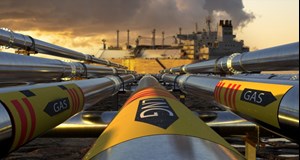China to seal most LNG purchase agreements of any nation
(Bloomberg) — A rush by China to sign new long-term liquefied natural gas (LNG) deals promises to give the nation even more control over the global market at a time when competition for cargoes is booming.
Chinese companies are sealing the most LNG purchase agreements of any nation and increasingly are becoming the sector’s key import intermediary. The Chinese buyers are reselling many of the cargoes to the highest bidders in Europe and Asia, effectively taking charge over a hefty chunk of supply.
Firms based in China account for roughly 15% of all contracts that’ll begin delivering LNG supply through 2027, according to an analysis of BloombergNEF data. That trend is set to increase as the companies seek to lock in more long-term agreements, which will effectively give their traders control over the fuel for decades.
The Asian nation’s position in the market could be a double-edged sword: China can provide stability during periods of global shortages, but it could withhold supply and drive up prices if the needs at home must be met.
“China is evolving from being a rapidly growing import market to playing a more flexible role with an increased ability to balance the global LNG market,” Shell Plc said in its annual LNG outlook report released last week.
China’s influence was highly visible last year during the global energy crunch, when strict Covid policies and high spot prices curbed the nation’s demand, prompting it to divert unwanted shipments to more needy regions.
“If not for the lower Chinese LNG demand in 2022, the global gas market — and Europe’s energy security — would be in a far more perilous state,” said Saul Kavonic, an energy analyst at Credit Suisse Group AG.
Swing supplier
The country is estimated to have resold at least 5.5 million tons of LNG last year, according to ENN Energy’s monthly research report in January. That’s equivalent to roughly 6% of total spot market volume, making the country an enormous swing supplier.
China has signed more contracts with U.S. export projects than any other nation since 2021, according to BloombergNEF data, and Sinopec inked one of the LNG industry’s largest deals ever with Qatar last year. More deals are on the horizon, as firms are in negotiations with exporters in the U.S., and also locked in talks with Qatar, Oman, Malaysia and Brunei, according to people with knowledge of the discussions.
China’s long-term contracted volume is likely to climb 12% in 2023 as agreements start from the U.S. and Qatar, BNEF analysts said in a report in January. The intensity of this year’s energy shortages may again depend on how much China decides to sell into the overseas market.
A key factor will be the extent of China’s economic recovery. The market fears a strong rebound will tighten global LNG supply and lead to another surge in prices, with the International Energy Agency calling the nation one of the “key exogenous risks” this year. However, the size of China’s LNG demand rebound is unclear amid strong pipeline deliveries and domestic production.
Trading expertise
Only in the last decade have major importers of LNG also become sellers. With the advent of flexible supply from new exporters like the U.S. and the proliferation of nimble trading desks, utilities are now able to divert shipments when demand is weak at home.
Japan, traditionally the world’s top LNG buyer, has become a major trader of the fuel. But its influence is set to wane as China is likely to become the world’s top importer this year amid a push to expand its trading expertise.
State-owned energy majors, including PetroChina and Sinopec, have set up trading units from London to Singapore. That means if a European importer wants to purchase a shipment from the U.S., for example, they may increasingly have to do so through a Chinese trading desk.



